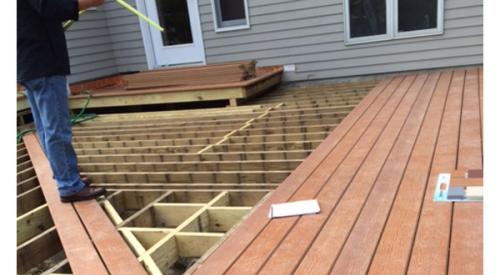Expanding homeowners’ outdoor living spaces has become one of the top remodeling projects. The projects often involve upgrades to better-quality materials, which usually means considering the variety of composite and alternative-material deck boards on the market.
Composites can provide low maintenance and longer life. But they’re not all created equal. Here are key tips to consider when helping homeowners decide on the best choice for their project.
1. Determine the deck’s size and budget. Regardless of which choice is made, composite deck boards will have a higher initial cost than wooden boards. But homeowners need to understand the value that a longer-life deck can provide by alleviating worries about splinters, mold, and rot, or replacing boards or the deck surface in a few years. They also won’t have to worry about sanding, staining, or resealing the deck every year, avoiding the material costs and effort. Higher-quality boards—which are only a percentage of the entire project—will pay back their premium over the years.
2. Research the base materials used in the boards. Many composite boards contain varying mixtures of wood, PVC, vinyl, and/or recycled plastics. There are exceptions, such as our own NyloDeck. It does not contain wood or PVC, using recycled carpet fiber for durability. Variations in plastics react differently to UV rays, moisture, freeze-thaw cycles, and other factors, so it is important to understand exactly what comprises the deck material. Here’s an overview from WGN-TV on some of the types of decking materials available: WGN-TV
3. Learn how easily the material can be worked. Some deck materials require special tools or fasteners. For instance, most composite boards cannot be fastened with the same screws as wood boards. If the wrong fasteners are used, the plastic material pushes up, creating a “mushrooming” effect. Fasteners also can create stress around the edge of a tight fastener, producing a white “halo” imprint. Each manufacturer provides lists of approved fasteners for both face-screws and hidden fasteners, and some have different application techniques. Some will be more expensive and will increase the deck’s cost.
4. Consider the location. Is the home near salt water? How cold are the winters and how hot are the summers? As with wood, composite materials are subject to weather changes. Knowing the material’s specific expansion and contraction rates is critical. It’s a key reason that contractors receive callbacks on deck projects. This is information the manufacturer should be willing to provide.
5. Available sizes. Not all products come in all sizes. For more complicated decks, look for products that offer longer spanning capability and longer lengths to provide more flexibility for design, avoid waste when cutting pieces, and decrease framing costs.
Homeowners have more options today when choosing deck boards than ever before. Find out if they are aware of all of their options and stay educated about the pros and cons of each choice. That knowledge will help ensure they have the best deck for their needs—and the contractor avoids any callbacks.







